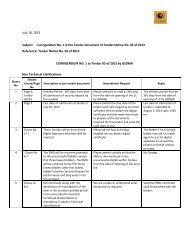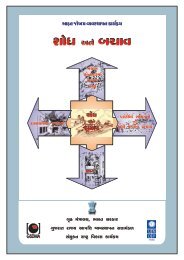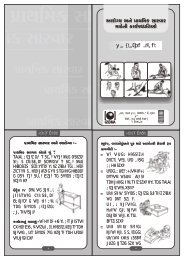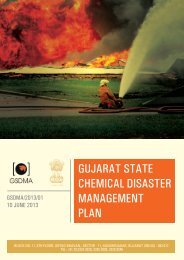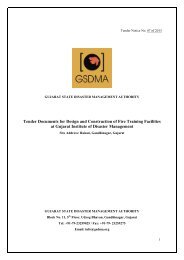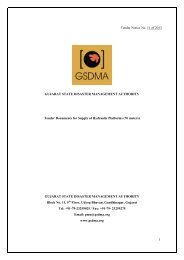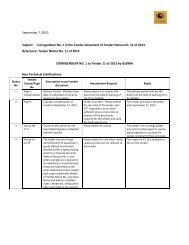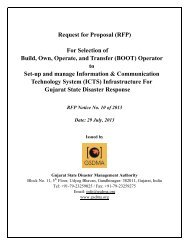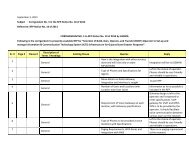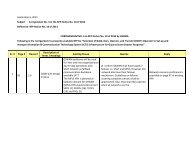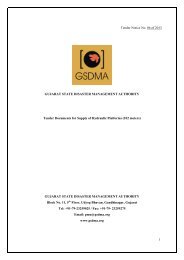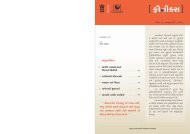Emergency Response Guidebook - Gujarat State Disaster ...
Emergency Response Guidebook - Gujarat State Disaster ...
Emergency Response Guidebook - Gujarat State Disaster ...
Create successful ePaper yourself
Turn your PDF publications into a flip-book with our unique Google optimized e-Paper software.
4-Green-bordered pages: This section contains three tables.Table 1 lists, by ID number order, TIH materials, including certain chemical warfare agents, andwater-reactive materials which produce toxic gases upon contact with water. This table providestwo different types of recommended safe distances which are "Initial isolation distances" and"Protective action distances". The materials are highlighted in green for easy identification inboth numeric (yellow-bordered pages) and alphabetic (blue-bordered pages) lists of theguidebook. This table provides distances for both small (approximately 208 liters or less for liquidsand 300 kilograms (660 pounds) or less for solids when spilled in water) and large spills (more than208 liters for liquids and more than 300 kilograms (660 pounds) for solids when spilled in water)for all highlighted materials. The list is further subdivided into daytime and nighttime situations.This is necessary due to varying atmospheric conditions which greatly affect the size of thehazardous area. The distances change from daytime to nighttime due to different mixing anddispersion conditions in the air. During the night, the air is generally calmer and this causes thematerial to disperse less and therefore create a toxic zone which is greater than would usuallyoccur during the day. During the day, a more active atmosphere will cause a greater dispersion ofthe material resulting in a lower concentration of the material in the surrounding air. The actualarea where toxic levels are reached will be smaller (due to increased dispersion). In fact, it is thequantity or concentration of the material Vapour that poses problems not its mere presence. The"Initial Isolation Distance" is a distance within which all persons should be considered forevacuation in all directions from the actual spill/leak source. It is a distance (radius) which definesa circle (Initial Isolation Zone) within which persons may be exposed to dangerous concentrationsupwind of the source and may be exposed to life threatening concentrations downwind of thesource. For example, in the case of Compressed gas, toxic, n.o.s., ID No. 1955, Inhalation HazardZone A, the isolation distance for small spills is 100 meters (300 feet), therefore, representing anevacuation circle of 200 meters (600 feet) in diameter. For the same material, the "ProtectiveAction Distance" for a small spill is 0.5 kilometers (0.3 mile) for a daytime incident and 2.2kilometers (1.4 miles) for a nighttime incident, these distances represent a downwind distancefrom the spill/leak source within which Protective Actions could be implemented. ProtectiveActions are those steps taken to preserve the health and safety of emergency responders and thepublic. People in this area could be evacuated and/or sheltered in-place. For more information,consult pages 285 to 291.What is a TIH? It is a gas or volatile liquid which is known to be so toxic to humans as to pose ahazard to health during transportation, or in the absence of adequate data on human toxicity, ispresumed to be toxic to humans because when tested on laboratory animals it has a LethalConcentration 50 (LC50) value of not more than 5000 ppm.It is important to note that even though the term zone is used, the hazard zones do not representany actual area or distance. The assignment of the zones is strictly a function of their LethalConcentration 50 (LC50); for example, TIH Zone A is more toxic than Zone D. All distances whichare listed in the green-bordered pages are calculated by the use of mathematical models for eachTIH material. For the assignment of hazard zones refer to the glossary.Table 2 lists, by ID number order, materials that produce large amounts of Toxic Inhalation Hazard(TIH) gases when spilled in water and identifies the TIH gases produced. These Water Reactivematerials are easily identified in Table 1 as their name is immediately followed by (when spilled inwater). Some Water Reactive materials are also TIH materials themselves (e.g., Brominetrifluoride (1746), Thionyl chloride (1836), etc.). In these instances, two entries are provided inTable 1 for land-based and water-based spills. If the Water Reactive material is NOT a TIH and thismaterial is NOT spilled in water, Table 1 and Table 2 do not apply and safety distances will be foundwithin the appropriate orange-bordered guide.Table 3 provides, by alphabetical order of material name, initial isolation and protective actiondistances for six Toxic Inhalation Hazard materials that may be more commonly encountered.The selected materials are:--Ammonia, anhydrous (UN1005)--Chlorine (UN1017)--Ethylene oxide (UN1040)--Hydrogen chloride (UN1050) and Hydrogen chloride, refrigerated liquid (UN2186)--Hydrogen fluoride (UN1052)--Sulfur dioxide/Sulphur dioxide (UN1079)The table provides Initial Isolation and Protective Action Distances for large spills (more than 208liters) involving different container types (therefore different volume capacities) for day time andnight time situations and different wind speeds.ISOLATION AND EVACUATION DISTANCESIsolation or evacuation distances are shown in the guides (orange-bordered pages) and in theTable 1 - Initial Isolation and Protective Action Distances (green-bordered pages). This mayconfuse users not thoroughly familiar with ERG2012. It is important to note that some guidesrefer only to non-TIH materials (36 guides), some refer to both TIH and non-TIH materials (21guides) and some (5 guides) refer only to TIH or Water-reactive materials (WRM). A guide refers toboth TIH and non-TIH materials (for example see GUIDE 131) when the following sentenceappears under the title EVACUATIONSpill: “See Table 1 - Initial Isolation and Protective ActionDistances for highlighted materials. For non-highlighted materials, increase, in the downwinddirection, as necessary, the isolation distance shown under ‘PUBLIC SAFETY.’” A guide refers onlyto TIH or WRM materials (for example see GUIDE 124) when the following sentence appearsunder the title EVACUATION-Spill: “See Table 1 - Initial Isolation and Protective Action Distances”.If the previous sentences do not appear in a guide, then this particular guide refers only to non-TIH materials (for example see GUIDE 128).Page 360Page 361



